Remember i was telling you about “Anti Anti Utopia”, the talk that Vicky Messi gave at the FILE festival symposium a week ago? She was highlighting media art projects from Latin America that ‘look beyond anti-utopia.’ The first work she presented was Arcángel Constantini‘s Nanodrizas, a fleet of “flying” saucers deployed in polluted waters to clean them up.
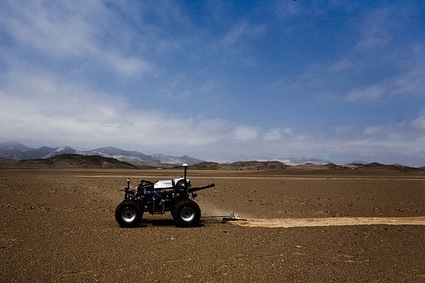
A second brilliant project she mentioned was Ciudad Nazca / Nazca City, a land art project in which a robot draws a true scale map of an imaginary city onto the surface of the Peruvian desert.
Artist Rodrigo Derteano‘s autonomous robot plows the desert ground to uncover its underlying, lighter color, using a technique similar to the one of the Nazca lines, the gigantic and enigmatic geoglyphs traced between 400 and 650 AD in the desert in southern Peru. Guided by its sensors, the robot quietly traced the founding lines of a new city that looks like a collage of existing cities from Latin America.
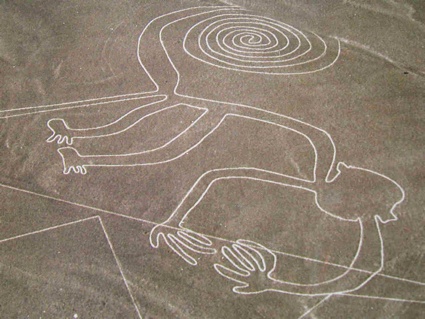 Nazca monkey, Peru
Nazca monkey, Peru
Because of the city would extend over several squared kilometers, the map can only be appreciated as a whole from certain a height by means of airplanes or satellite imaging. Just like the Nazca lines.
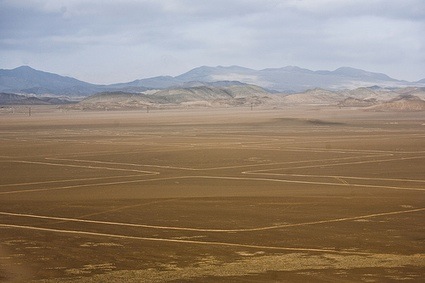
The project invites to reflect upon the explosive urbanization of the deserts of the Peruvian coast, taking place since the middle of the last century, and its consequences on environmental sustainability and the quality of living.
I asked Rodrigo to talk to us about Ciudad Nazca:
Hello Rodrigo! What is the motivation behind the project? During her presentation at FILE, Vicky mentioned the spectacular growth of the city of Lima and the need to find new ways of designing and envisioning cities, maybe by building them in the desert. Can you expand on this?
I live and grew up in Lima. About 60% of the city today lies within the desert, most of it grew without any serious urban planning. It’s a self-made metropolis, the second largest city built in the desert after Cairo. It grew from 1 million to 8 million people in less than 60 years. There’s a lot of problems derived from this development in terms of sustainability and living standards which exacerbate the huge inequality of our society. The desert plays a big role in this regard. People living in desert areas of the city are usually poor and often have to pay more for water than those living in more centric (richer) areas. They also lack proper infrastructure and have much less public places and parks. For a long time, these areas were not considered part of the city by the ruling class and the authorities until they became the majority.
By drawing a gigantic map of a city onto the desert, the project not only seeks to draw attention to this facts, but questions our very concept of city, specially in regards to its environment. Lima is a sort of negation of the desert. Our model and ideal of city is very occidental, and does not adapt very well to its context. The desert is seen a kind of non-place, not a part of our living environment. In this sense, there’s a sort of irony in using a robot to draw a city onto the desert, as if it would be drawing it on the surface of Mars (exploring the outer space for the possibility of urban life).
I’m also fascinated by the Nasca people and their lines (200 BC – 600 AD). Studying theories about them, I found their notion of desert as ritual space, and therefore an expansion of their living space, to be in sharp contrast to our notion today. Some see the Nasca lines as cult to fertility and life in the desert, trying to communicate beyond. In this sense, Nasca City is kind of a cult to urban life in the desert today, not communicating beyond, but within our society…
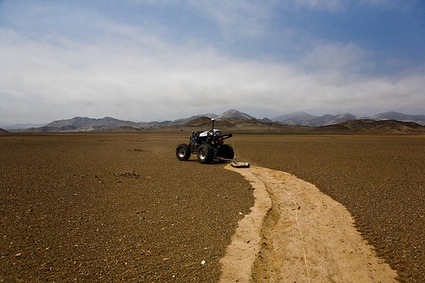
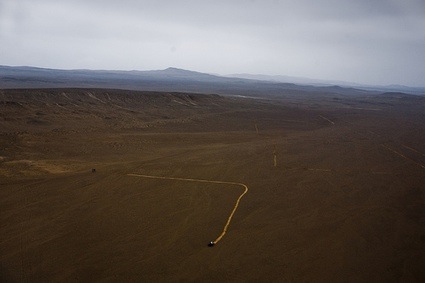 I was also interested in the cities you selected for the final collage. How did you chose them? Why Belo Horizonte and Rio de Janeiro rather than Sao Paulo? Why Bogota rather than Medellin for example?
I was also interested in the cities you selected for the final collage. How did you chose them? Why Belo Horizonte and Rio de Janeiro rather than Sao Paulo? Why Bogota rather than Medellin for example?
The project required an interdisciplinary group of people working together to make it happen. In regards to the design of the city we worked together with the Latin American architecture collective Supersudaca, represented by the 51-1 architecture studio in Lima. The collective proposed to do a real scale collage of pieces of the 10 largest cities in Latin America (Sao Paulo is included). They would overlap at the borders creating new urban forms and zones of conflict. The idea was to create a map of mixed references, city patterns already charged with meaning, that people would be able to recognise, compare, and understand the scale of the drawing according to their own real life experience.
Why 10? Well, they like to put up simple rules. The cities pieces were put together conserving their relative geographical position and original orientation.
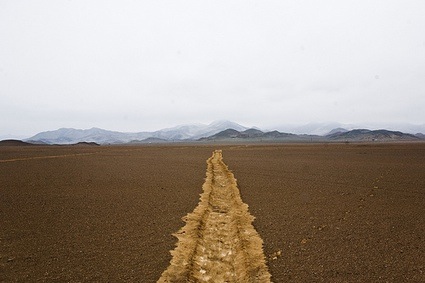 The city drawn in the desert is ephemeral is that correct? Isn’t it disheartening to dedicate so much energy and see the city being slowly erased by the wind and other natural elements?
The city drawn in the desert is ephemeral is that correct? Isn’t it disheartening to dedicate so much energy and see the city being slowly erased by the wind and other natural elements?
Sometimes I also find it disheartening, but most of the time I think it is ok for it to be slowly erased by the wind. The lines loose the sharp contrast with the surface in a couple of weeks, but the relief will be visible for years. I don’t know if I would find the drawing and whole action equally meaningful in, let’s say, 20 years. The desert is quite a special place for me, and I had my thoughts about leaving permanent marks that large on its surface.
For it to stay forever, we would have had to do it in a terrain with almost identical conditions as in Nasca, which is a protected area classified as world heritage by UNESCO. We would have ended in jail for sure, if we had done it over there. Which brings me to question number 5…
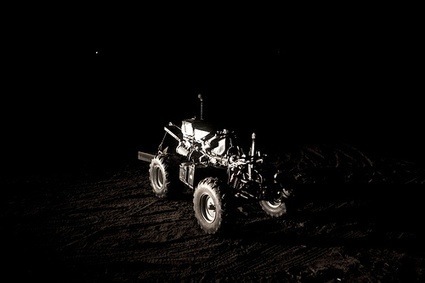 How long did it take to draw the whole city and did you have to stay near the robot constantly to monitor its work?
How long did it take to draw the whole city and did you have to stay near the robot constantly to monitor its work?
The drawing took 5 days (4 under ideal conditions). We had to rescue the robot sometimes and had some problems, but most of the time, it would do fine by itself.
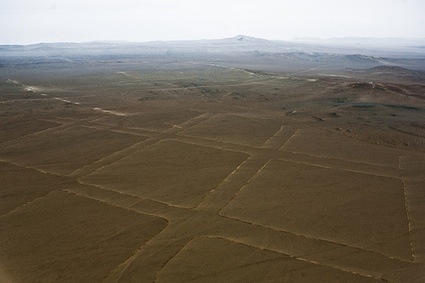
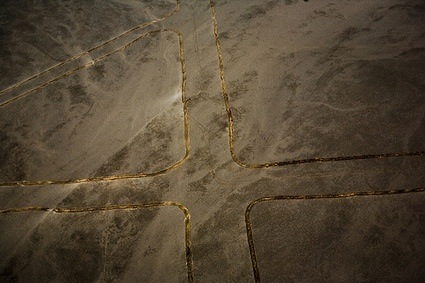 Did you need to obtain special permits to do this piece of land art or can anyone do anything they fancy in the desert?
Did you need to obtain special permits to do this piece of land art or can anyone do anything they fancy in the desert?
In theory, you can’t do what you want in the desert (in Peru), unless you own it. And even then, you’ll have to do an official and quite expensive study certifying the absence of archeological rests. In a protected area like Nazca, it would be a serious crime (to destroy national heritage). We certainly could not buy up that amount of terrain (!!). But it is permitted to drive around in non protected areas, which also leaves marks. So there’s kind of a gray zone. In practice, people exploit the landscape in all sorts of ways, but we wanted to go public with it. We had to make sure we could do it, or at least be prepared for the consequences. The local authorities were sympathetic to the project and we got an unofficial permit…
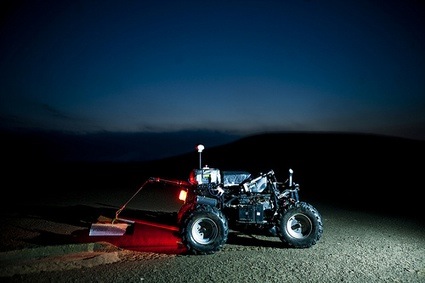 Are you planning to repeat or show the project elsewhere in the near future?
Are you planning to repeat or show the project elsewhere in the near future?
The project is not completely finished, because there are lots of follow ups. Maybe I’ll take on the topic in further projects or exhibitions. Maybe someday we repeat the drawing process, but it’s quite a production and I have no concrete plans. There are no exhibitions planned at the moment, but I have a lot of material and would like to show it again.
Thanks Rodrigo!
And if you speak spanish, check out this interview that Vicky did with Rodrigo:
All images courtesy of Rodrigo Derteano.
Previously: Nanodrizas, “flying” saucers for polluted waters.
